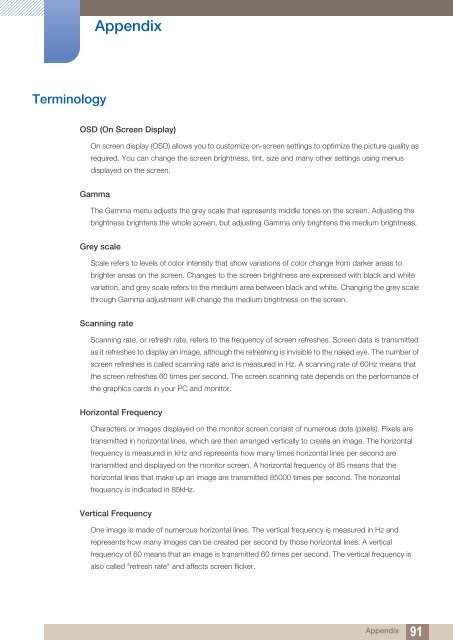Samsung Samsung 27-Inch Screen Monitor with HDMI - LS27B350HSZ/ZA - User Manual (ENGLISH)
Samsung Samsung 27-Inch Screen Monitor with HDMI - LS27B350HSZ/ZA - User Manual (ENGLISH)
Samsung Samsung 27-Inch Screen Monitor with HDMI - LS27B350HSZ/ZA - User Manual (ENGLISH)
You also want an ePaper? Increase the reach of your titles
YUMPU automatically turns print PDFs into web optimized ePapers that Google loves.
Appendix<br />
Terminology<br />
OSD (On <strong>Screen</strong> Display)<br />
On screen display (OSD) allows you to customize on-screen settings to optimize the picture quality as<br />
required. You can change the screen brightness, tint, size and many other settings using menus<br />
displayed on the screen.<br />
Gamma<br />
The Gamma menu adjusts the grey scale that represents middle tones on the screen. Adjusting the<br />
brightness brightens the whole screen, but adjusting Gamma only brightens the medium brightness.<br />
Grey scale<br />
Scale refers to levels of color intensity that show variations of color change from darker areas to<br />
brighter areas on the screen. Changes to the screen brightness are expressed <strong>with</strong> black and white<br />
variation, and grey scale refers to the medium area between black and white. Changing the grey scale<br />
through Gamma adjustment will change the medium brightness on the screen.<br />
Scanning rate<br />
Scanning rate, or refresh rate, refers to the frequency of screen refreshes. <strong>Screen</strong> data is transmitted<br />
as it refreshes to display an image, although the refreshing is invisible to the naked eye. The number of<br />
screen refreshes is called scanning rate and is measured in Hz. A scanning rate of 60Hz means that<br />
the screen refreshes 60 times per second. The screen scanning rate depends on the performance of<br />
the graphics cards in your PC and monitor.<br />
Horizontal Frequency<br />
Characters or images displayed on the monitor screen consist of numerous dots (pixels). Pixels are<br />
transmitted in horizontal lines, which are then arranged vertically to create an image. The horizontal<br />
frequency is measured in kHz and represents how many times horizontal lines per second are<br />
transmitted and displayed on the monitor screen. A horizontal frequency of 85 means that the<br />
horizontal lines that make up an image are transmitted 85000 times per second. The horizontal<br />
frequency is indicated in 85kHz.<br />
Vertical Frequency<br />
One image is made of numerous horizontal lines. The vertical frequency is measured in Hz and<br />
represents how many images can be created per second by those horizontal lines. A vertical<br />
frequency of 60 means that an image is transmitted 60 times per second. The vertical frequency is<br />
also called "refresh rate" and affects screen flicker.<br />
Appendix<br />
91
















